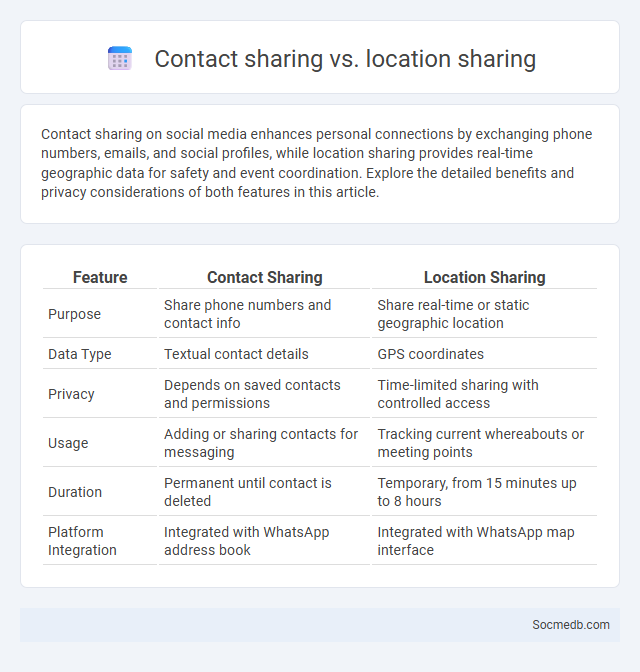
Photo illustration: Contact sharing vs Location sharing
Contact sharing on social media enhances personal connections by exchanging phone numbers, emails, and social profiles, while location sharing provides real-time geographic data for safety and event coordination. Explore the detailed benefits and privacy considerations of both features in this article.
Table of Comparison
| Feature | Contact Sharing | Location Sharing |
|---|---|---|
| Purpose | Share phone numbers and contact info | Share real-time or static geographic location |
| Data Type | Textual contact details | GPS coordinates |
| Privacy | Depends on saved contacts and permissions | Time-limited sharing with controlled access |
| Usage | Adding or sharing contacts for messaging | Tracking current whereabouts or meeting points |
| Duration | Permanent until contact is deleted | Temporary, from 15 minutes up to 8 hours |
| Platform Integration | Integrated with WhatsApp address book | Integrated with WhatsApp map interface |
Introduction to Contact Sharing and Location Sharing
Contact sharing on social media enables users to quickly exchange phone numbers, emails, and profiles to enhance connectivity and communication. Location sharing allows users to broadcast or restrict real-time geographical information through platforms like Facebook, Instagram, and Snapchat for safety, convenience, and social interaction. Both features leverage metadata and privacy settings to balance user accessibility with security.
Defining Contact Sharing: What It Means
Contact sharing on social media involves exchanging personal or professional information like phone numbers, email addresses, or social profiles through platforms such as Facebook, LinkedIn, or Instagram. This feature facilitates networking, collaboration, and communication by allowing you to connect with friends, colleagues, or potential clients efficiently. Understanding the privacy settings and permissions associated with contact sharing is essential to control who accesses your information and protect your digital presence.
Understanding Location Sharing: Core Concepts
Understanding location sharing involves recognizing how social media platforms use GPS data to tag your posts and update your followers about your whereabouts. Your device communicates with satellites or nearby Wi-Fi networks to provide precise geolocation, enabling features like check-ins and location-based content recommendations. Being aware of privacy settings helps you control who can see your shared location, safeguarding your personal information.
Key Differences Between Contact and Location Sharing
Contact sharing on social media involves exchanging personal information such as phone numbers, email addresses, or social profiles to establish direct communication, while location sharing provides real-time or static geographic data to indicate a user's whereabouts. Contact sharing emphasizes building connections and networking, whereas location sharing focuses on enhancing real-time interactions, safety, or logistical coordination. Privacy settings and user control vary significantly, with location sharing often requiring more stringent permissions due to its sensitivity and potential for misuse.
Use Cases: When to Share Contacts vs. Locations
Sharing contacts on social media proves essential for networking events, professional collaborations, and expanding business connections, enabling quick access to phone numbers, emails, and social profiles. Location sharing optimizes meetups, event coordination, and real-time updates during travel or emergencies by providing geographic context and navigation details. Choosing between contacts and locations depends on the immediacy of interaction needs and the nature of the social engagement, enhancing communication efficiency.
Privacy Implications: Contact Sharing vs. Location Sharing
Sharing contact information on social media platforms raises privacy concerns due to potential unauthorized access and misuse of personal connections, increasing risks of phishing and identity theft. Location sharing further exacerbates privacy vulnerabilities by exposing users to real-time tracking, stalking, and targeted advertisements based on geographic data. Users must carefully manage permissions and understand platform-specific privacy settings to mitigate these risks effectively.
Security Risks and Best Practices
Social media platforms pose significant security risks including data breaches, identity theft, and phishing attacks targeting user information. To mitigate these threats, users should implement strong, unique passwords, enable two-factor authentication, and regularly update privacy settings to control data visibility. Educating users about recognizing suspicious links and avoiding oversharing personal details further enhances online safety and prevents unauthorized access.
Popular Apps for Contact and Location Sharing
Popular social media apps like WhatsApp, Snapchat, and Facebook Messenger dominate contact and location sharing by enabling real-time GPS tracking and seamless messaging features. These platforms integrate location tags, live location sharing, and geotagged status updates to enhance user connectivity and situational awareness. Advanced privacy settings within these apps allow users to control who can view their location, balancing convenience with security.
User Experience: Ease of Sharing Contacts vs. Locations
Social media platforms prioritize user experience by simplifying the ease of sharing contacts through integrated address books and one-tap sharing features, enhancing connectivity. Sharing locations is optimized via GPS integration and real-time map updates, enabling precise and context-aware geotagging. Balancing privacy controls with seamless sharing ensures users maintain control while engaging effortlessly with their network.
Future Trends in Digital Sharing Technologies
Future trends in digital sharing technologies emphasize the integration of blockchain for enhanced security and transparency in social media platforms. Decentralized social networks are poised to gain traction, enabling users to control their data and content monetization directly. Advances in augmented reality (AR) and virtual reality (VR) will foster immersive sharing experiences, transforming how users interact and engage with digital content online.
 socmedb.com
socmedb.com